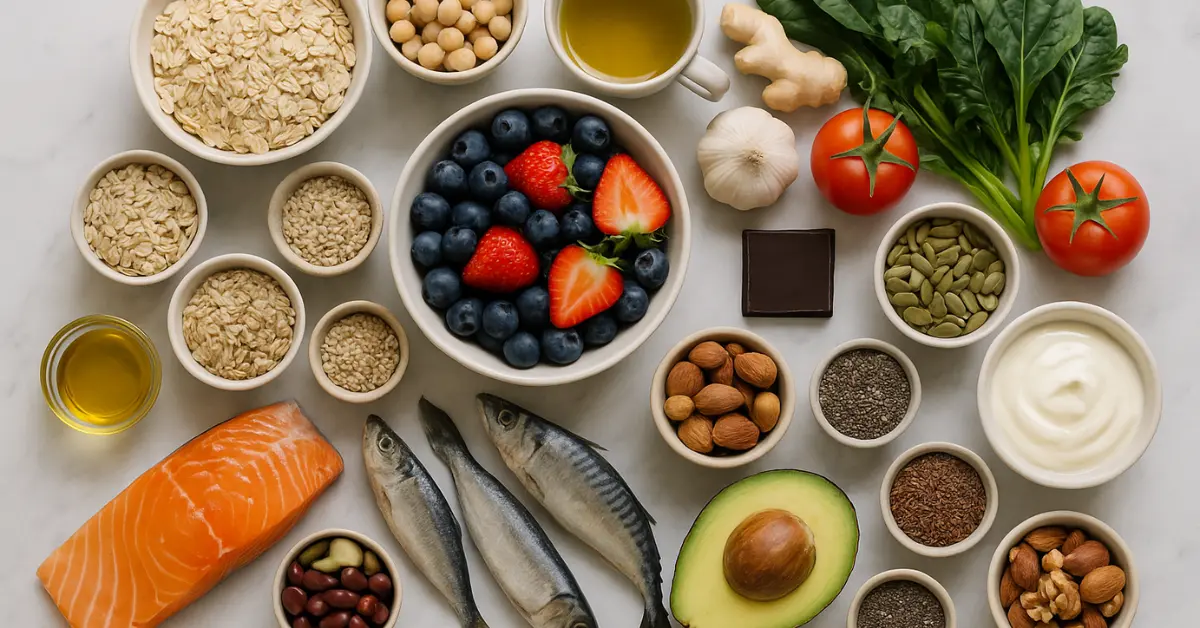HDL Foods List means practical, pantry-friendly choices—plus the right portions—that can nudge up HDL (“good”) cholesterol or improve how HDL works in your body. The big idea is simple: swap saturated fat for unsaturated fat, add omega-3s and soluble fiber, and stick to a mostly plant-forward plate. That pattern, backed by heart-health guidelines and clinical research, supports healthier lipids and better HDL function.
Quick note: HDL is just one marker. Focus on your overall risk (ApoB/LDL, blood pressure, glucose, weight, smoking, activity) and talk to your doctor if you’re on cholesterol medication. Lifestyle patterns and cardiorespiratory fitness matter as much as the number.
How to use this list
- Portions below are per day (or per serving) for most adults; adjust if you’re smaller, larger, or on a specific plan.
- Cook smart: Prefer grilling, steaming, sautéing; keep oils within your daily fat budget.
- Stack the wins: Aim to include 2–3 items from different groups daily (e.g., nuts + oats + olive/mustard oil).
25 HDL-friendly foods (with realistic portions)
Omega-3–rich fish (2–3 times/week)
- Sardines (100 g cooked) – Small, fatty fish with robust omega-3s; budget-friendly.
- Indian mackerel / Bangda (100 g cooked) – Excellent EPA/DHA source.
- Salmon (100 g cooked) – When available, a reliable omega-3 option.
Why they help: Marine omega-3s improve triglycerides and support HDL function within a heart-healthy pattern.
Nuts (a small handful = ~28 g)
- Almonds (28 g) – Linked to modest HDL rise when replacing refined-carb snacks.
- Walnuts (28–30 g) – Rich in ALA (plant omega-3) and polyphenols.
- Pistachios (28 g) – Unsaturated fats + fiber for a smart snack.
- Peanuts/groundnuts (28 g) – Accessible MUFA source (mind salted/fried versions).
Why they help: Replacing refined carbs with nuts can improve HDL levels and function; walnut/almond trials also show better overall lipid profiles.
Seeds (add to breakfast, salads, curd)
- Flaxseed, ground (1–2 Tbsp / 10–20 g) – Plant omega-3 (ALA) + lignans.
- Chia seeds (1 Tbsp / ~12 g) – Swell in liquids; easy for puddings.
- Sesame/Til (1 Tbsp / ~9 g) – Traditional, versatile; try dry-roasted.
- Pumpkin seeds (1 Tbsp / ~10 g) – Adds crunch, minerals, healthy fats.
Why they help: Plant omega-3s and unsaturated fats support a better lipid pattern.
Healthy oils (use to replace, not add on top)
- Extra-virgin olive oil (1 Tbsp / 15 ml) – For finishing, dressings, light sauté.
- Mustard oil (1 Tbsp / 15 ml) – Popular in Indian kitchens; rich in MUFA/PUFA.
- Groundnut (peanut) or canola oil (1 Tbsp / 15 ml) – Neutral, high in MUFA.
Why they help: Swapping saturated/trans fats for unsaturated oils improves cholesterol balance and HDL function in Mediterranean-style patterns.
Soy & plant proteins
- Tofu/soy paneer (100 g) – Lean protein, very adaptable to Indian dishes.
- Boiled soybeans/edamame (¾ cup cooked / ~75–100 g) – Snack or stir-fry.
- Curd + roasted chana topping (150 g + 2 Tbsp chana) – Protein + fiber combo.
Why they help: Plant proteins help displace saturated fat; several studies tie legumes/nuts/olive oil/fish to improved HDL function.
Whole grains & pulses
- Oats (40 g dry; ~1 cup cooked) – Rich in beta-glucan soluble fiber.
- Barley (40–50 g dry; ~1 cup cooked) – Hearty swap for rice in soups/khichdi.
- Chickpeas/Chana (¾ cup cooked / ~120 g) – Great for chaat, salads, curries.
- Kidney beans/Rajma (¾ cup cooked / ~120 g) – Try with brown rice for fiber.
- Moong/Masoor dal (¾ cup cooked) – Everyday dal that adds viscous fiber.
Why they help: Soluble-fiber-rich grains and pulses lower LDL and support an overall healthier lipid profile; HDL changes vary by study, but they fit perfectly into HDL-friendly dietary patterns.
Produce rich in polyphenols & pectin
- Berries (1 cup) – Strawberries/blueberries or local seasonal options (e.g., jamun when in season).
- Citrus (1 medium orange/sweet lime) – Pectin + flavonoids; great snack.
- Avocado (½ medium / 70–100 g) – Creamy MUFA swap for butter/cream.
Why they help: Polyphenol-rich produce and MUFA-rich avocado fit into Mediterranean-style eating that enhances HDL’s protective functions.
Smart plate: portions & swaps that actually move the needle
- Daily fat budget: Keep total fats within your calorie needs, but tilt toward MUFA/PUFA, not butter/cream/ghee or ultraprocessed snacks. Use 1–2 Tbsp of healthy oil across meals; don’t pour freely.
- One handful of nuts replaces a biscuit/namkeen snack.
- One omega-3 fish meal replaces a red-meat or fried entrée.
- Oats/barley dalia replaces sugary breakfast cereal; dal + whole grain replaces refined flour dishes.
- Avocado or olive-oil dressing replaces cream-based spreads/sauces.
What about exercise and weight?
The fastest non-food lever is activity: even brisk walking builds better HDL over time. Also, losing 5–10% of body weight (if you have weight to lose) typically bumps HDL while improving blood pressure and glucose. Pair the food swaps above with 150–300 minutes/week of moderate activity (or intervals if your doctor allows).
A few FAQs (evidence-aware)
- “Will barley or oats raise HDL?” They mainly lower LDL and improve overall profile; HDL may not always rise, but your risk picture improves. Keep them in.
- “Dark chocolate?” A small 20–30 g piece (≥70% cocoa) can fit as a swap, not an add-on. Focus on the overall pattern—olive oil, nuts, legumes, fish, whole grains, produce—which improves HDL function.
Bottom line
You don’t need exotic foods to help your HDL. Build your day around unsaturated fats (oils, nuts, seeds, avocado), omega-3 fish, soluble-fiber grains and pulses, and colorful produce—and walk more. That combination is the most reliable, real-world way to support HDL and overall heart health.
Disclaimer: This article is for general information and is not a substitute for professional medical advice. If you have heart disease, diabetes, kidney disease, or are on lipid-lowering medi

